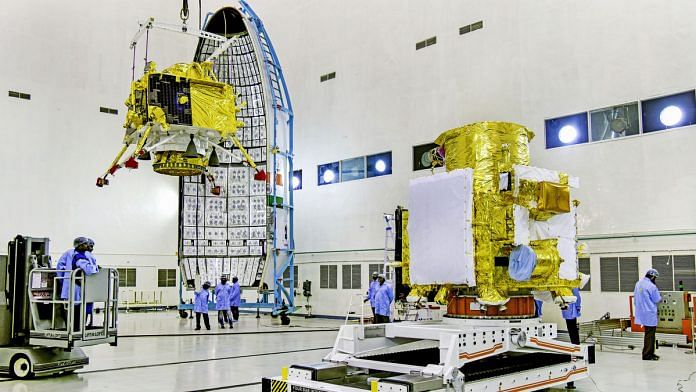New Delhi: Moon mission Chandrayaan-2’s Vikram lander made a hard landing 500 metres from the designated site on the lunar surface due to a deviation in the parameters in the final stage of its descent, the Narendra Modi government officially confirmed for the first time Wednesday.
The Indian Space Research Organisation (ISRO) had lost communication with the lander aboard its second moon mission on 7 September. So far, there had been no official word on the fate of Vikram.
In a written reply to a question in the Lok Sabha, Jitendra Singh, Minister of State in the Prime Minister’s Office (PMO), said, “The first phase of descent was performed nominally from an altitude of 30 km to 7.4 km above the moon surface. The velocity was reduced from 1683 m/s to 146 m/s.”
However, during the second phase of descent, the reduction in velocity was more than the designed value.
“Due to this deviation, the initial conditions at the start of the fine braking phase were beyond the designed parameters. As a result, Vikram hard landed within 500 m of the designated landing site,” Singh said.
This was India’s first attempt to carry out a soft landing on the moon. Due to the unsuccessful landing, the indigenously developed rover, Pragyan — meant to explore a region near the south pole of the moon — could also not be rolled out.
Also read: Discovery of water on moon: What India’s first Chandrayaan mission achieved a decade ago
The mission
The Chandrayaan-2 spacecraft, comprising an orbiter, lander and rover, was successfully launched on-board indigenous GSLV MK III-M1 Mission on 22 July this year.
After accomplishing five orbit raising manoeuvres and trans lunar injection, the spacecraft was successfully inserted into the lunar orbit on 20 August. A series of manoeuvres were then carried out to lower the altitude of to an orbit of 119×127 km.
The lander, Vikram, was then separated from the orbiter on 2 September as planned. After two successful de-orbiting manoeuvres, a powered descent of the lander was initiated on 7 September to achieve soft landing on the moon’s surface.
However, signal from the lander was lost when it was less than two km from the designated landing site.
In his reply, Singh confirmed that most of the components of technology demonstration, including the launch, critical orbit manoeuvres, lander separation, de-boost and rough braking phase were successfully accomplished.
All eight state-of-the-art scientific instruments of the orbiter are also performing according to design and providing valuable scientific data. The data received from the orbiter is also being continuously fed to the scientific community. Due to the precise launch and orbital manoeuvres, the mission life of the orbiter increased to seven years from the planned one year.
Last month, ISRO released the first illuminated image of the moon’s surface.
The space agency is now reportedly planning a second attempt at soft landing by November next year. Earlier this month, ISRO chief K. Sivan had also said that the agency is determined to perform a space landing on the moon.
Also read: NASA unveils new spacesuits for astronauts for 2024 Moon mission



